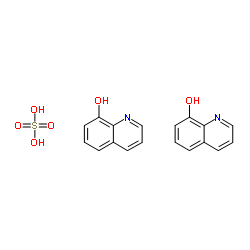8-羟基喹啉硫酸盐

8-羟基喹啉硫酸盐结构式

|
常用名 | 8-羟基喹啉硫酸盐 | 英文名 | 8-Hydroxyquinoline hemisulfate |
|---|---|---|---|---|
| CAS号 | 134-31-6 | 分子量 | 388.394 | |
| 密度 | 1.26g/cm3 | 沸点 | 267ºC at 760 mmHg | |
| 分子式 | C9H7NO.1/2H2O4S | 熔点 | ~175 °C | |
| MSDS | 中文版 美版 | 闪点 | 143.1ºC | |
| 符号 |

GHS07 |
信号词 | Warning |
|
Selective growth-inhibitory effect of 8-hydroxyquinoline towards Clostridium difficile and Bifidobacterium longum subsp. longum in co-culture analysed by flow cytometry.
J. Med. Microbiol. 63(Pt 12) , 1663-9, (2014) The major risk factor for Clostridium difficile infection (CDI) is the use of antibiotics owing to the disruption of the equilibrium of the host gut microbiota. To preserve the beneficial resident probiotic bacteria during infection treatment, the use of mole... |
|
|
Translating clinical findings into knowledge in drug safety evaluation--drug induced liver injury prediction system (DILIps).
J. Sci. Ind. Res. 65(10) , 808, (2006) Drug-induced liver injury (DILI) is a significant concern in drug development due to the poor concordance between preclinical and clinical findings of liver toxicity. We hypothesized that the DILI types (hepatotoxic side effects) seen in the clinic can be tra... |
|
|
Developing structure-activity relationships for the prediction of hepatotoxicity.
Chem. Res. Toxicol. 23 , 1215-22, (2010) Drug-induced liver injury is a major issue of concern and has led to the withdrawal of a significant number of marketed drugs. An understanding of structure-activity relationships (SARs) of chemicals can make a significant contribution to the identification o... |
|
|
A predictive ligand-based Bayesian model for human drug-induced liver injury.
Drug Metab. Dispos. 38 , 2302-8, (2010) Drug-induced liver injury (DILI) is one of the most important reasons for drug development failure at both preapproval and postapproval stages. There has been increased interest in developing predictive in vivo, in vitro, and in silico models to identify comp... |
|
|
New 2,3-diaminopropionic acid inhibitors of AGE and ALE formation.
Org. Biomol. Chem. 11(5) , 773-80, (2013) Novel 2,3-diaminopropionic acid-based molecules were synthesised and tested successfully as glyoxal/methylglyoxal scavengers and as AGE inhibitors. Addition of an 8-hydroxyquinoline moiety led to an increase of the overall activity. The compounds tested in th... |
|
|
NMR, DFT and luminescence studies of the complexation of Al(III) with 8-hydroxyquinoline-5-sulfonate.
Dalton Trans. 41(40) , 12478-89, (2012) Multinuclear ((1)H, (13)C and (27)Al) magnetic resonance spectroscopy (1D and 2D), DFT calculations and fluorescence have been used to study the complexation of 8-hydroxyquinoline-5-sulfonate (8-HQS) with Al(III). The study combines the high sensitivity of lu... |
|
|
Structural and photophysical studies on gallium(III) 8-hydroxyquinoline-5-sulfonates. Does excited state decay involve ligand photolabilisation?
Dalton Trans. 42(10) , 3682-94, (2013) Multinuclear ((1)H, (13)C and (71)Ga) magnetic resonance spectroscopy (1D and 2D), DFT calculations and luminescence techniques have been used to study 8-hydroxyquinoline-5-sulfonate (8-HQS) and its complexes with Ga(III) in aqueous solutions. The study combi... |
|
|
Iron overload causes oxidative stress and impaired insulin signaling in AML-12 hepatocytes.
Dig. Dis. Sci. 58(7) , 1899-908, (2013) Iron overload is associated with increased severity of nonalcoholic fatty liver disease (NAFLD) including progression to nonalcoholic steatohepatitis and hepatocellular carcinoma.To identify potential role(s) of iron in NAFLD, we measured its effects on pathw... |
|
|
Experimental and DFT studies of (E)-2-[2-(2,6-dichlorophenyl)ethenyl]-8-hydroxyquinoline: electronic and vibrational properties.
Spectrochim. Acta. A. Mol. Biomol. Spectrosc. 106 , 275-83, (2013) The title molecule (E)-2-[2-(2,6-dichlorophenyl)ethenyl]-8-hydroxyquinoline (DPEQ) was synthesized and characterized by FT-IR, UV-vis, NMR spectroscopy. The molecular geometry, vibrational frequencies and gauge independent atomic orbital (GIAO) 1H and 13C NMR... |
|
|
Analytical performance of a lab-made concomitant metal analyzer to generate volatile species of Ag, Au, Cd, Cu, Ni, Sn and Zn using 8-hydroxyquinoline as a reaction media.
Talanta 100 , 45-50, (2012) This study evaluated the main parameters affecting Ag, Au, Cd, Cu, Ni, Sn and Zn vapor generation using a lab-made concomitant metal analyzer (CMA) as a reaction chamber and gas-liquid separator. The modifier used in the reaction media was 8-hydroxyquinoline,... |